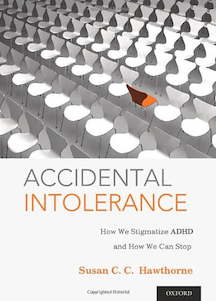By Germaine Cornelissen-Guillaume
The topic of this book relates to an important problem at a critical developmental age that is likely to have a lasting impact, not just in the life of the afflicted children but also on society as a whole. Susan Hawthorne addresses it primarily from a philosophical perspective. Her thorough analysis and neutral review of the literature covers several aspects of Attention Deficit Hyperactivity Disorder, from controversies related to its diagnosis to those associated with therapeutic choices. She makes the case that while ADHD is now viewed as a treatable condition, the framework within which choices are made unintentionally reinforce intolerance of individuals diagnosed with this condition.
The author argues that medical, scientific, and cultural practices should be amended to reduce such intolerance, a goal far more ambitious than increasing tolerance, which would imply that there is something wrong with people diagnosed with ADHD rather than just viewing these individuals as being merely different, embracing the diversity of human personalities. This is indeed a tall order, for which Hawthorne offers some recommendations in her last chapter.
Perhaps the most pragmatic step likely to bring welcome change consists of avoiding dichotomization. Being categorized as having ADHD, in fact, does not result from a simple, unambiguous test, but from a score resulting from a questionnaire addressing a wide range of different behaviors. The subjectivity usually associated with such an approach should not be overlooked, and the question may rightfully be asked, why are more than 10% of children now diagnosed with the condition? Does the problem lie with the children or with society itself? These are issues worth exploring further in the next edition of the book. The danger of treating “symptoms” (if human variation and underperformance can be called “symptoms”) rather than the cause (still not fully understood, perhaps rooted in today’s society itself) is real and should not be underestimated!
The author’s other recommendations—carefully using facts and values in all decisions and actions relevant to the condition, studying new disease models and forms of intervention, and changing society rather than individuals—are logical and well outlined in theory but may prove much harder to implement in practice. While some general guidelines are provided, actual change is not likely to happen without a much further unified effort from parents and teachers, researchers in the field, and policy-makers. The detailed compilation of research in education, psychology, and medical science provided in this book is nevertheless definitively a step in the right direction.
Germaine Cornelissen-Guillaume is a professor of integrative biology and physiology and director of the Halberg Chronobiology Center at the University of Minnesota, Twin Cities.




